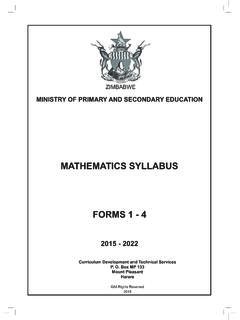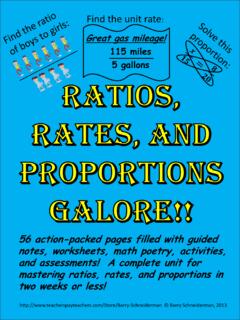Transcription of The Mathematics of Ratios, Rates and Proportions Teaching ...
1 Developmental Math An Open Program Instructor Guide Unit 4: Ratios, Rates and Proportions Learning Objectives Instructor Notes The Mathematics of Ratios, Rates and Proportions Teaching Tips: Challenges and Approaches Additional Resources Instructor Overview Tutor Simulation: Tracking Soccer Team Standings Instructor Overview Puzzle: Out of Proportion Instructor Overview Project: Painting Your Way to Profit Common Core Standards Some rights reserved. See our complete Terms of Use. Monterey Institute for Technology and Education (MITE) 2012 To see these and all other available Instructor Resources, visit the NROC Network. Unit 4 Table of Contents Developmental Math An Open Program Instructor Guide Unit 4: Ratios, Rates and Proportions Lesson 1: Ratio and Rates Topic 1: Simplifying Ratios and Rates Learning Objectives Write ratios and Rates as fractions in simplest form.
2 Find unit Rates . Find unit prices. Lesson 2: Proportions Topic 1: Understanding Proportions Learning Objectives Determine whether a proportion is true or false. Find an unknown in a proportion. Solve application problems using Proportions . Unit 4 Learning Objectives Developmental Math An Open Program Instructor Guide Unit 4: Ratios, Rates and Proportions Instructor Notes The Mathematics of Ratios, Rates and Proportions This unit introduces students to ratios. They'll learn to recognize and apply these numbers in familiar situations and to describe them both verbally and symbolically. By the time they complete the unit, they'll be able to define, write, simplify, and evaluate ratios, Rates , unit Rates and prices, and Proportions . Teaching Tips: Challenges and Approaches Students all deal happily with ratios every single day, they just don't realize it. Once they learn a few definitions and techniques, put in some practice, and see how useful ratios are, this unit should go smoothly for most of them.
3 Preparation Much of the work is an extension of the ideas and skills learned in Unit 2, Fractions and Mixed Numbers. Before tackling ratios, make sure that students have mastered that material. The emphasis on this unit should be the practical application of fractions. Recognizing Ratios Students experience ratios all the time they read speed limit signs on the way to school, they hear commercials claiming that nine out of ten dentists prefer a particular type of toothpaste, and they figure out how much money they'll make working over the weekend. They just don't call these values ratios. Make that connection use lots of examples and problems to show how ordinary and everyday ratios are, and students will be more interested and comfortable in working with them. Laying out all the different ways to write ratios will help students realize they've seen them before: Unit 4 Instructor Notes Developmental Math An Open Program Instructor Guide [From Lesson 1, Topic 1, Topic Text] It will also help to identify some of the key words and symbols that signal a ratio is at hand, such as: per for every to / : Ratios vs.
4 Rates Students should pick up the concept of ratios easily comparing two numbers is something they've already done plenty of. But they may struggle a bit with Rates . Many think that rate means speed, and at least at first, they'll be confused that prices or wages can also be expressed as Rates . Giving a clear definition of rate will help, as will more examples, like the following: Developmental Math An Open Program Instructor Guide [From Lesson 1, Topic 1, Worked Example 4] This shows students that Rates compare two numbers measured in different units to be a rate, all that matters is that the units are different. Be sure to point out that all Rates are ratios but not all ratios are Rates . Cross-multiplying This unit teaches students several new ideas and terms, but really only one fresh technique cross-multiplication. Students are shown how to use it to decide if a proportion is true, and also to calculate an unknown, as seen below: Developmental Math An Open Program Instructor Guide [From Lesson 2, Topic 1, Presentation] It is important to emphasize that cross-multiplying should be done only after checking that the units are consistent.
5 In fact, it s important to stress that students must watch units carefully throughout these lessons. It s easy for them to focus so much on getting the numbers correct that they forget to pay attention to the units. Make a point of checking units when working through problems in the classroom. One word of warning: For whatever reason, students really like cross-multiplying. They remember learning this in elementary school and it sticks with them. Once they relearn this skill, they may try to apply it where it shouldn t be used, for example when multiplying or dividing two fractions. Keep In Mind As always, application problems should be used frequently. Show students explicitly how ratios, Rates , and Proportions are useful in everyday life. We've all stood indecisively in the grocery store trying to figure out which package is the better buy: Developmental Math An Open Program Instructor Guide [From Lesson 1, Topic 1, Topic Text] Additional Resources In all Mathematics , the best way to really learn new skills and ideas is repetition.
6 Problem solving is woven into every aspect of this course each topic includes warm-up, practice, and review problems for students to solve on their own. The presentations, worked examples, and topic texts demonstrate how to tackle even more problems. But practice makes perfect, and some students will benefit from additional work. A good website to review all the skills learned in this unit can be found at #topic7. Summary Unit 4 teaches students the practical applications of ratios and Proportions . They'll learn how to write and simplify ratios, find unit Rates and prices, and evaluate Proportions . Because ratios are really fractions, this material reinforces what was learned Unit 2: Fractions. Developmental Math An Open Program Instructor Guide Unit 4: Ratios, Rates and Proportions Instructor Overview Tutor Simulation: Tracking Soccer Team Standings Purpose This simulation allows students to demonstrate their understanding of ratios.
7 Students will be asked to apply what they have learned to solve a problem involving: Ratios Proportions Applying Ratios and Proportions to Real-World Situations Problem Students are presented with the following problem: It's soccer season, and somebody is tracking team standings. Guess what .. that somebody is you. Enjoy the games. Recommendations Tutor simulations are designed to give students a chance to assess their understanding of unit material in a personal, risk-free situation. Before directing students to the simulation, Make sure they have completed all other unit material. Explain the mechanics of tutor simulations. o Students will be given a problem and then guided through its solution by a video tutor; o After each answer is chosen, students should wait for tutor feedback before continuing; o After the simulation is completed, students will be given an assessment of their efforts. If areas of concern are found, the students should review unit materials or seek help from their instructor.
8 Emphasize that this is an exploration, not an exam. Unit 4 Tutor Simulation Developmental Math An Open Program Instructor Guide Unit XX: Ratios, Rates and Proportions Instructor Overview Puzzle: Out of Proportion Objectives Out of Proportion lets students see how well they understand ratios and Proportions . In order to succeed, they'll have to write a proportion based on a verbal description, and then calculate the missing value that will make the equation true. Description This puzzle is made up of 20 word problems. In each one, players are given enough information to set up a proportion with one unknown value. Once they arrange the relationship correctly, Unit 4 Puzzle Developmental Math An Open Program Instructor Guide they're asked to choose the value that will satisfy the proportion. Students can figure the answers in their heads or on paper using the method they prefer, such as finding the equivalent fraction or cross-multiplying.
9 Out of Proportion is suitable for both individual and group play. It could also be used in the classroom to illustrate the horizontal and vertical symmetry of Proportions . Developmental Math An Open Program Instructor Guide Unit 4: Ratios, Rates and Proportions Instructor Overview Project: Painting Your Way to Profit Student Instructions Introduction There are numerous cases in which proportional reasoning helps to clarify thinking and illuminate the actual costs associated with doing business. Task In this project, your group will draft a plan for financing the start-up of your own painting company. The owner of a local apartment complex is interested in hiring you to paint all of the apartments in his complex. By using proportional thinking, your group will minimize costs, determine the terms of a contract with the owner of the apartment complex, and make a presentation to the bank from which you will seek a loan.
10 Instructions Solve each problem in order and save your work as you progress, as you will create a professional presentation at the conclusion of the project. 1. First problem: Make a trip to the local paint store or, alternatively you can shop online at , which provides prices and specifications on paint products. You will be painting inside, so select a single brand of interior paint. Be sure that the paint is sold in quarts, gallons, and 5-gallon sizes. Record the relevant information in the chart below. Use a proportion to determine the number of gallons in 1 quart, expressing your answer as a decimal. Note that there are 4 quarts in 1 gallon. In the table below, record all the volumes in gallons. [Hint: To convert quarts to gallons, consider a proportion of the form 1 g a llo n4 q u a r t s x g a llo n s1 q u a r t.] Unit 4 Project Developmental Math An Open Program Instructor Guide Now compute the unit price of the paint.




